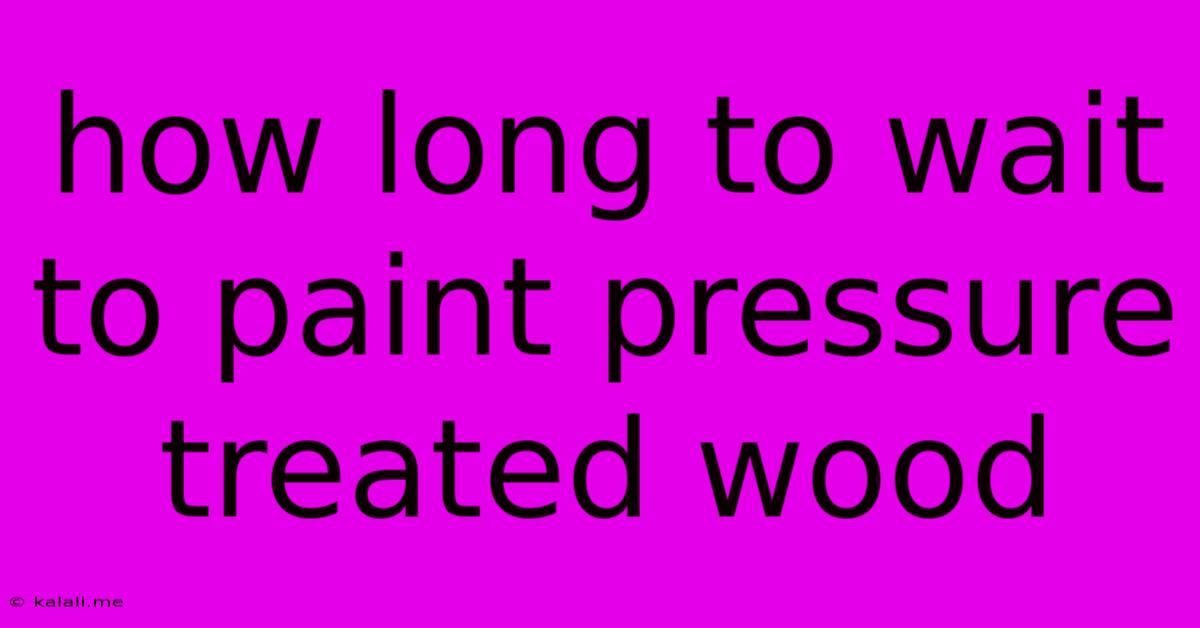How Long To Wait To Paint Pressure Treated Wood
Kalali
Jun 01, 2025 · 3 min read

Table of Contents
How Long to Wait to Paint Pressure Treated Wood: A Comprehensive Guide
Meta Description: Learn the optimal waiting time before painting pressure-treated wood. This guide covers factors influencing drying time, paint types best suited for treated lumber, and crucial preparation steps for a long-lasting finish.
Pressure-treated lumber is a popular choice for outdoor projects due to its durability and resistance to rot and insects. However, before you can enjoy its beauty, you need to understand how long to wait before painting it. Rushing the process can lead to peeling paint, poor adhesion, and ultimately, a shorter lifespan for your project. This comprehensive guide will help you determine the ideal waiting period and ensure a successful painting project.
Understanding the Drying Process
The key factor determining how long you should wait is the drying time of the pressure-treated wood. This isn't simply about the surface feeling dry; it's about the moisture content within the wood itself reaching a suitable level. Pressure-treated lumber is infused with preservatives, and these, combined with the moisture content, significantly impact the drying process.
Several factors influence how long it takes for pressure-treated wood to dry sufficiently before painting:
- Type of Wood: Different wood species absorb and release moisture at varying rates. Denser hardwoods generally take longer to dry than softer woods.
- Thickness of Lumber: Thicker pieces of wood will naturally take longer to dry completely than thinner boards.
- Climate and Weather Conditions: Hot, dry, and windy conditions accelerate drying, while humid or rainy conditions prolong the process.
- Treatment Type: The specific type of preservative used can affect the drying time. Some preservatives can slow down the drying process slightly.
Determining the Optimal Waiting Period
There's no single magic number for how long to wait. However, a general guideline is to wait at least 30 days for every inch of wood thickness. So, a 2-inch thick board should ideally wait for at least 60 days. This allows sufficient time for the wood to dry and for the preservative chemicals to settle.
However, always check the manufacturer's recommendations on the lumber packaging. This is crucial as it provides specific guidance tailored to the specific treatment used. This information will often supersede any generalized advice.
Signs of Sufficient Drying
Before painting, closely examine the wood. Look for these indicators of sufficient drying:
- Moisture Meter Readings: Using a moisture meter is the most accurate way to determine the wood's moisture content. Aim for a moisture content of around 15% or less.
- Lack of Visible Moisture: The surface of the wood should feel dry to the touch and there shouldn't be any visible moisture beading or condensation.
- Consistent Color: The wood should be evenly colored; darker or wetter patches indicate incomplete drying.
Choosing the Right Paint
Once your pressure-treated lumber is sufficiently dry, selecting the correct paint is equally important for a long-lasting finish.
- Exterior-Grade Paints: Only use high-quality exterior-grade paints specifically designed to withstand the elements and adhere well to wood.
- Oil-Based vs. Water-Based: Both oil-based and water-based paints can be used, but each has its own pros and cons. Oil-based paints offer superior durability and water resistance, while water-based paints are low-VOC and easier to clean up.
- Primers: Using a quality primer before applying the topcoat is often recommended, especially for pressure-treated wood. A primer enhances paint adhesion and provides a more even finish.
Proper Surface Preparation
After selecting the paint, make sure to properly prepare the surface of the wood:
- Cleaning: Remove any dirt, debris, mildew, or loose fibers from the wood surface. Use a stiff brush or pressure washer to effectively clean the lumber.
- Sanding: Lightly sanding the surface will create a smoother finish and improve paint adhesion.
By carefully following these steps, you will achieve a high-quality paint job that will enhance the look of your pressure treated wood project and maximize its lifespan. Remember to always prioritize patience; proper drying and preparation are crucial for a successful outcome.
Latest Posts
Latest Posts
-
How To Text People From Ur Broken Android
Jun 03, 2025
-
Why Is New England So Liberal
Jun 03, 2025
-
Who Is The Person Daniel Sees In Daniel 10
Jun 03, 2025
-
Can You Run Sum In Varchar
Jun 03, 2025
-
Starter Solenoid Clicks But No Crank
Jun 03, 2025
Related Post
Thank you for visiting our website which covers about How Long To Wait To Paint Pressure Treated Wood . We hope the information provided has been useful to you. Feel free to contact us if you have any questions or need further assistance. See you next time and don't miss to bookmark.